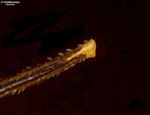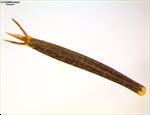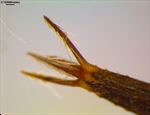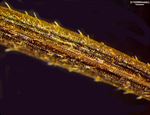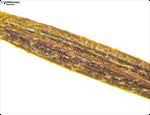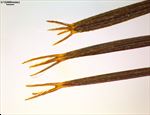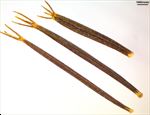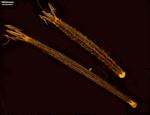Taxonomy
Bidens bipinnata L., Sp. Pl. 2:832. 1753Common name
Spanish needles, bipinnate beggar's ticks
Description
Propagule or dispersal unit is the fruit with pappus. Fertile part 7-12(-18) mm long, 0.5-1.1 mm wide, in side view mostly +/- equal thickness (cylindrical), widest in upper part (obovoid) or widest in the middle, +/- straight or conspicuously curved, the upper (apical) end narrowing, in cross-section angular (prismatic), rarely flattened, basal scar (carpopodium) pronounced and well-differentiated, off to the side (oblique) or at least asymmetric, beak (=thinner sterile stalk between seed and pappus) absent, wings absent, fruit surface black, smooth (except at cellular level), with no hairs (glabrous), thickened margin absent, longitudinal ribs present, 4-8, their surfaces smooth or toothed, serrated or scale-like, with no hairs (glabrous) or simple straight hairs.
Pappus type awns or spines, pappus elements all +/- similar, up to 1.4-4 mm long, in one row, number of pappus elements three to four, rarely two, persistent, the individual awns serrated or barbed, +/- divergent, +/- straight.
Ecology
Large and semi-woody but short-lived herb, seeds dispersed by sticking to fur or clothes. Warm-temperate to tropical regions. Found in crops and fallow fields, disturbed forests, and along roads.
Native range
Uncertain, but often presumed to be either North America (United States, Mexico) or South America
Introduced range
United States, Mexico, Ecuador, Brazil, Western and Central Europe, tropical West Africa, potentially Zimabwe and South Africa, Madagascar, China, Japan, Taiwan, Australia (given uncertainty around its native range, this list provides all areas with more than occasional occurrences registered by GBIF)
